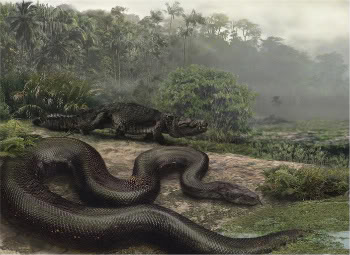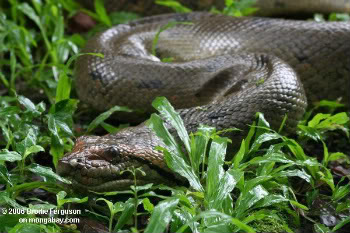Paleontologists have recently uncovered the world’s largest snake announces a paper in Nature. Measuring an astonishing 42 to 45 feet, the Titanoboa cerrejonensis makes the anaconda look diminutive. In fact the prehistoric serpent even makes once-ridiculous horror movie snakes appear conservative.
“Truly enormous snakes really spark people’s imagination, but reality has exceeded the fantasies of Hollywood,” said Jonathan Bloch, one of the leaders of the party that discovered the prehistoric serpent. “The snake that tried to eat Jennifer Lopez in the movie Anaconda is not as big as the one we found.”
Paleontologist Jason Head, part of the team that analyzed the remains, added that “this colossal, boa constrictor-like creature stretched longer than a city bus and weighed more than a car.”
 This artist’s rendering of Titanoboa cerrejonensis demonstrates the great snake’s size. It is anticipated the boa spent much of its life in or near water. Picture by:Jason Bourque, University of Florida. |
The titanoboa was discovered in Colombia. The dig organized by Carlos Jaramillo, a paleobotanist with the Smithsonian Tropical Research Institute in Panama and Bloch, curator of vertebrate paleontology at the University of Florida’s Florida Museum of Natural History and undertaken in the Cerrejon Coal Mine. Digging in the mine was imperative, because fossil hunting in the tropics has proven nearly impossible due to the lack of exposed rock. The mine, one of the world’s largest open pit mines, however provided ample opportunity to explore once covered bare rock.
“Prior to our work, there had been no fossil vertebrates found between 65 million and 55 million years ago in tropical South America, leaving us with a very poor understanding of what life was like in the northern Neotropics,” Bloch said. “Now we have a window into the time just after the dinosaurs went extinct and can actually see what the animals replacing them were like.”
The snake lived during the Paleocene Epoch, the era lasting ten million years after the extinction of the dinosaurs. After the extinction of the dinosaurs, it appears that the titanoboa became one of the region’s super-predators. Nearby the snake fossils, the researchers found skeletons of giant turtles and primitive crocodile-like reptiles that the scientists believe may have been prey for the titanoboa.
 The longest living snake: a green anaconda in the Amazon. |
To estimate the length and weight of the titanoboa based on the fossilized vertebrae, the researchers called in Jason Head, a specialist on fossilized snakes at the University of Toronto and David Polly, a paleontologist at the University of Indiana. Head and Polly researchers used the relationship between body size and veterbrae of contemporary snakes to estimate the size of the Titanoboa. Their estimate of 42.7 feet and 2,5000 pounds makes the snake the largest non-marine vertebrate of its epoch.
“The snake’s body was so wide that if it were moving down the hall and decided to come into my office to eat me, it would literally have to squeeze through the door,” Head said.
Let’s see Hollywood top that.
For information on how this find may help scientists better understand tropical forests affected by global warming: Monstrous prehistoric snake provides glimpse of warmer tropical forests
Related articles
10-pound ‘Giant Frog From Hell’ discovered in Madagascar
(02/18/2008)
Researchers have discovered the remains of what may be the largest frog ever to exist.
Working in Madagascar, scientists led by Stony Brook University paleontologist Dr. David Krause found the remains of a 16-inch, 10-pound frog that lived some 65 to 70 million years ago. The frog, known as Beelzebufo or devil frog, was so large and powerfully built, it may have eaten baby dinosaurs.
Photos: world’s largest spitting cobra discovered in Kenya
(12/09/2007)
The world’s largest spitting cobra has been discovered in Kenya, according to WildlifeDirect, a conservation group. The newly described snake species, which measures up to 15 feet long, was named Naja ashei after James Ashe, founder of a snake farm on Kenya’s coast where the cobra is found.














